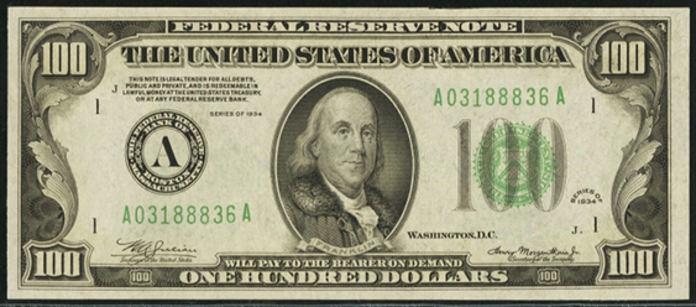Get Value Now
| Item | Info |
|---|---|
| Series | 1934 |
| Type | Federal Reserve Note |
| Seal Varieties | Light Green, Dark Green |
| Signature Varieties | 1. Julian - Morgenthau |
| Varieties | 12 Banks Issued Notes: 1. Atlanta 2. Boston 3. Chicago 4. Cleveland 5. Dallas 6. Kansas City 7. Minneapolis 8. New York 9. Philadelphia 10. Richmond 11. San Francisco 12. St. Louis |
| Star Notes | 24 Varieties with Star Serial Numbers. |
| Mules | 10 Varieties have mule plates. Back required for identification. |
| See Also | If your note doesn't match try: 1. 1929 $100 National Bank Notes 2. 1934 $100 Gold Certificate 3. 1934A $100 Federal Reserve Note 4. 1934B $100 Federal Reserve Note 5. 1934C $100 Federal Reserve Note 6. 1934D $100 Federal Reserve Note |
| Example Rarity | Kansas City Reverse plate 113 & above, signatures Julian - Morgenthau with Dark Green seal. Important: Star serial number. Also: Mule plates. Comment: Solid collectible potential. Notes About Uncirculated or better value to $3000. 2 |
Value: 1934 $100 Federal Reserve Notes value $110 in Very Fine condition. Star notes value $150 or more depending on Federal Reserve district. Notes from some districts are rarer than others.
Value depends on condition. Notes without stars are common. The BEP printed millions for each district. 1934 $100 stars are also common by collecting standards. Star notes from the Cleveland, Kansas City, Dallas and San Francisco districts are most desirable. They can value $800+ in uncirculated condition.
Light Green Seal vs Dark Green Seal
Some notes have a light, limey green seal. Others have a dark forest green seal. Dark green seal notes are more common than light green seals.
Check for Mule Notes
Mule notes were printed with micro size numbers on the front and macro numbers on the back. The reverse can also be true. Only 1934 $100 Dark Green Seal notes can have mule plates.
The BEP’s transition from micro to macro sized numbers began in 1938 and concluded in 1953. During this time, multiple series, denominations and types had mule plate configurations. The government preferred to reuse older plates rather than destroying them.*
Ultimately, some mule notes became instant rarities because the BEP printed so few. Mule star notes are even rarer. I can help you identify a mule note. Submit photos of the front and back of your note.
Thus, 1934 $100 bills come in 6 possible varieties. Each has been rank ordered from common to rare. Some differences may exist depending on your note’s federal reserve district.
Light Green Seal Notes
- Non-star notes
- Star notes
Dark Green Seal Notes
- Non-star notes
- Non-star mule notes
- Star notes
- Mule star notes
*Source: Standard Guide to Small-Size U.S. Paper Money 1928 to Date by John Schwartz and Scott Lindquist
Explain 1934 $100 Federal Reserve Note Value
Paper Money of the United States indicates the government issued between 1 million – 6 million notes per Federal Reserve District. It printed far fewer star notes and mules. Still rarer are mule star notes. Each note has Julian-Morgenthau signatures.
United States Federal Reserve Note History
United States Federal Reserve Note History.
No Obligations Offers and AppraisalsPlease submit a good photo or scan. It will be identified and evaluated. Understand there may be subtle differences between the image you see above and your note. Signatures, design, markings and note condition will determine the offer price. Notes in Uncirculated or better condition receive the best offers.
Appraisals can be estimated for wholesale and retail prices. Wholesale is what dealers typically pay. Retail is what a collector might pay. Retail is slightly higher in most cases.
Please visit this page for USA Paper Money Reference. Do not treat this page as a reference guide, it is for appraisal and acquisition purposes only.
